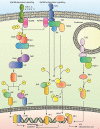Neural injury following stroke: are Toll-like receptors the link between the immune system and the CNS?
- PMID: 20649586
- PMCID: PMC2958633
- DOI: 10.1111/j.1476-5381.2010.00864.x
Neural injury following stroke: are Toll-like receptors the link between the immune system and the CNS?
Abstract
The CNS can exhibit features of inflammation in response to injury, infection or disease, whereby resident cells generate inflammatory mediators, including cytokines, prostaglandins, free radicals and complement, chemokines and adhesion molecules that recruit immune cells, and activate glia and microglia. Cerebral ischaemia triggers acute inflammation, which exacerbates primary brain damage. The regulation of inflammation after stroke is multifaceted and comprises vascular effects, distinct cellular responses, apoptosis and chemotaxis. There are many cell types that are affected including neurons, astrocytes, microglia and endothelial cells, all responding to the resultant neuroinflammation in different ways. Over the past 20 years, researchers examining brain tissue at various time intervals after stroke observed the presence of inflammatory cells, neutrophils and monocytes at the site of injury, as well as the activation of endogenous glia and microglia. This review examines the involvement of these cells in the progression of neural injury and proposes that the Toll-like receptors (TLRs) are likely to be an integral component in the communication between the CNS and the periphery. This receptor system is the archetypal pathogen sensing receptor system and its presence and signalling in the brain following neural injury suggests a more diverse role. We propose that the TLR system presents excellent pharmacological targets for the design of a new generation of therapeutic agents to modulate the inflammation that accompanies neural injury.
Figures


Similar articles
-
Toll-like receptors in health and disease in the brain: mechanisms and therapeutic potential.Clin Sci (Lond). 2011 Nov;121(9):367-87. doi: 10.1042/CS20110164. Clin Sci (Lond). 2011. PMID: 21745188 Free PMC article. Review.
-
Innate immunity and neuroinflammation in the CNS: the role of microglia in Toll-like receptor-mediated neuronal injury.Glia. 2010 Feb;58(3):253-63. doi: 10.1002/glia.20928. Glia. 2010. PMID: 19705460 Review.
-
Neuronal injury in chronic CNS inflammation.Best Pract Res Clin Anaesthesiol. 2010 Dec;24(4):551-62. doi: 10.1016/j.bpa.2010.11.001. Epub 2010 Nov 29. Best Pract Res Clin Anaesthesiol. 2010. PMID: 21619866 Review.
-
Targeting the Toll-like receptor pathway as a therapeutic strategy for neonatal infection.Am J Physiol Regul Integr Comp Physiol. 2021 Dec 1;321(6):R879-R902. doi: 10.1152/ajpregu.00307.2020. Epub 2021 Oct 6. Am J Physiol Regul Integr Comp Physiol. 2021. PMID: 34612068 Review.
-
Inflammatory and neuroimmunomodulatory changes in acute cerebral ischemia.Cerebrovasc Dis. 2009;27 Suppl 1:48-64. doi: 10.1159/000200441. Epub 2009 Apr 3. Cerebrovasc Dis. 2009. PMID: 19342833 Review.
Cited by
-
Bone Marrow-Derived IL-1Ra Increases TNF Levels Poststroke.Cells. 2021 Apr 20;10(4):956. doi: 10.3390/cells10040956. Cells. 2021. PMID: 33924148 Free PMC article.
-
Ghrelin inhibits high glucose-induced PC12 cell apoptosis by regulating TLR4/NF-κB pathway.Inflammation. 2013 Dec;36(6):1286-94. doi: 10.1007/s10753-013-9667-2. Inflammation. 2013. PMID: 23813326
-
The Delta-Subunit Selective GABA A Receptor Modulator, DS2, Improves Stroke Recovery via an Anti-inflammatory Mechanism.Front Neurosci. 2019 Oct 29;13:1133. doi: 10.3389/fnins.2019.01133. eCollection 2019. Front Neurosci. 2019. PMID: 31736685 Free PMC article.
-
Prognostic performance of serum YKL-40 for one-year clinical outcomes in acute ischemic stroke.Aging (Albany NY). 2023 Feb 25;15(4):1199-1209. doi: 10.18632/aging.204553. Epub 2023 Feb 25. Aging (Albany NY). 2023. PMID: 36880855 Free PMC article.
-
Interleukin-16 polymorphism is associated with an increased risk of ischemic stroke.Mediators Inflamm. 2013;2013:564750. doi: 10.1155/2013/564750. Epub 2013 Oct 31. Mediators Inflamm. 2013. PMID: 24288444 Free PMC article.
References
-
- Allahtavakoli M, Moloudi R, Arababadi MK, Shamsizadeh A, Javanmardi K. Delayed post ischemic treatment with Rosiglitazone attenuates infarct volume, neurological deficits and neutrophilia after embolic stroke in rat. Brain Res. 2009;1271:121–127. - PubMed
-
- An H, Xu H, Yu Y, Zhang M, Qi R, Yan X, et al. Up-regulation of TLR9 gene expression by LPS in mouse macrophages via activation of NF-kappaB, ERK and p38 MAPK signal pathways. Immunol Lett. 2002;81:165–169. - PubMed
-
- Asea A, Rehli M, Kabingu E, Boch JA, Bare O, Auron PE, et al. Novel signal transduction pathway utilized by extracellular HSP70: role of toll-like receptor (TLR) 2 and TLR4. J Biol Chem. 2002;277:15028–15034. - PubMed
-
- Babcock AA, Toft-Hansen H, Owens T. Signaling through MyD88 regulates leukocyte recruitment after brain injury. J Immunol. 2008;181:6481–6490. - PubMed
Publication types
MeSH terms
Substances
LinkOut - more resources
Full Text Sources
Other Literature Sources
Medical
Miscellaneous

